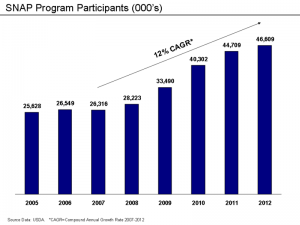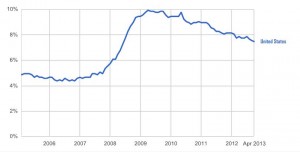A great example of our nation’s partisan politics is the careless discussion of the Supplemental Nutrition Assistance Program (SNAP) or food stamps. Lately there have been several measures passed by the House of Representatives which feed on misinformation or play upon voter’s perceptions. As citizens we are left to dissect rampant talking points and blatant fabrications with little help from our media outlets. In general, misinformation has become a lucrative industry with talk show hosts, pundits, and politicians selling unsubstantiated data and twisted logic. This leads to conversations driven by 45 second sound bites, 140 character tweets, and out-of-context statements which are shallow and divisive.
 SNAP has expanded rapidly under the Obama administration making it a popular talking point with right-wing pundits. The guilty-by-association rhetoric leaves out critical information needed to understand the trends, and focuses entirely on the “what” and not the “why”. Republicans are correct to point out food stamp participants have grown 65 percent since 2008 increasing spending to an all time high of $74B (2 percent of budget), but when asked the cause they fall into the trap of popular propaganda. They do not know that 50 percent of food stamp recipients are under the age of 18, or 15 percent are elderly. They do not understand that 20 percent of food stamp households support the disabled. They incorrectly believe that President Obama has passed legislation that enables the expansion of the program or incentivizes participation.
SNAP has expanded rapidly under the Obama administration making it a popular talking point with right-wing pundits. The guilty-by-association rhetoric leaves out critical information needed to understand the trends, and focuses entirely on the “what” and not the “why”. Republicans are correct to point out food stamp participants have grown 65 percent since 2008 increasing spending to an all time high of $74B (2 percent of budget), but when asked the cause they fall into the trap of popular propaganda. They do not know that 50 percent of food stamp recipients are under the age of 18, or 15 percent are elderly. They do not understand that 20 percent of food stamp households support the disabled. They incorrectly believe that President Obama has passed legislation that enables the expansion of the program or incentivizes participation.
In addition, Republican’s association of food stamps with left-leaning blue states lacks credible data. The highest SNAP participating state is Mississippi with 22.5 percent of their residents receiving assistance. 7 of the 10 highest SNAP participating states are red and primarily in the South. The state with the most people on food stamps is Texas, which is surprising given California has 12 million more residents. Even the reddest of states, Utah, has seen participation double in the last five years (from 5 percent to 10 percent). Regardless of state targeted data, food stamps are distributed somewhat evenly. Currently 16.8 percent of red state residents are receiving food stamps compared with 14.3 percent of blue state residents.
 The solitary driving force behind the expansion of SNAP was the rapid unemployment spike from 2008 – 2010 which led to more households applying for assistance. In the final year of President Bush’s administration unemployment jumped from 4.9 percent to 8.7 percent and continued to 9.8 percent under President Obama. The doubling of the unemployment rate corresponds with the doubling of food stamp participants under President Obama’s tenure. As families were left without employment they turned to the government for support.
The solitary driving force behind the expansion of SNAP was the rapid unemployment spike from 2008 – 2010 which led to more households applying for assistance. In the final year of President Bush’s administration unemployment jumped from 4.9 percent to 8.7 percent and continued to 9.8 percent under President Obama. The doubling of the unemployment rate corresponds with the doubling of food stamp participants under President Obama’s tenure. As families were left without employment they turned to the government for support.
It is not fair or reasonable to hold the Obama Administration accountable for SNAP participation increases. It is fair to hold the Obama Administration accountable for households leaving the program now that unemployment is improving (7.8 percent). Moving people off of government assistance is a sign of progress and should be the desire of every Democrat who understands the bridging role of social programs. However, decreasing participation needs to be persuaded, not forced, as any mandated cut in SNAP will disproportionately impact the elderly, disabled, and children.
Food stamp talking points, like all issues, need to be challenged and understood. Focusing too quickly on the “what” will lead us into a partisan spin zone and dull our problem solving ability. We need to ask the right questions, understand the impact of our choices, and weigh the impact to our fellow citizens. Accepting popular talking points to support an ideology is not only disingenuous, but undermines the need for solution-oriented conversations to tackle our country’s major challenges.
Great post Matt. It’s surprising how the clear truth of SNAP participation increases paralleling the unemployment rise, which you aptly pointed out, has been completely ignored in the right-wing media’s talking points. And the GOP’s recent attempt to cut food stamps in the failed farm bill doesn’t address the underlying issue of unemployment.
Has the media got any soundbites on the “worthy” vs. “unworthy” poverty argument? I can’t remember if politicians have spoken to it, but I know individual citizens rant about it all the time. I’m sure you’re familiar with “no steak on welfare” variation that’s now “no chips, cookies, junk food on welfare.” Never mind that the program itself has said repeatedly that restricting more food types would cost more money– at best, the argument then becomes about “fancy” junk food like Mexican Coca-Cola with cane sugar instead of good ol’ subsidized corn syrup.
Education about the program is horrible. Few people know that seeds and edible garden plants have been allowed since the program began, but where would most recipients plant a garden? There was no space when my family lived in an apartment– no plots, and outdoor pots were vulnerable to marauding children that would vandalize anything they could reach if you dared scold them.